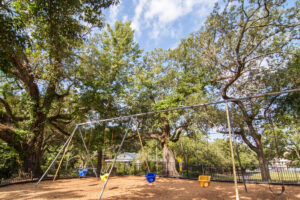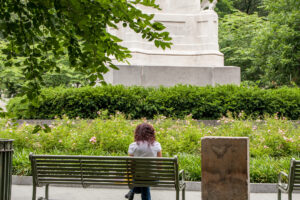By Eli Lewis, NASF Policy Coordinator
The wide-ranging societal impacts of urban forests, which consist of not only trees but also urban parks, landscaped boulevards, greenways, and gardens in an urbanized area,1 were the focus of the Second World Forum on Urban Forests. I had the opportunity to join the conference, which brought together city planners, public health stakeholders, academic researchers, technology start-ups, government officials, urban foresters, and professionals from several other sectors to discuss how to reach the potential of urban and community forestry.

Urban forests are enjoying the spotlight right now, and for good reason. Urban forests can help achieve food and nutrition security, mitigate risks of natural disasters, create recreational, cultural, and social opportunities, and facilitate climate adaptation and mitigation strategies.2 The Biden Administration’s Inflation Reduction Act (IRA) put $1.5 billion towards urban and community forestry, the most significant investment to date. While this funding alone is extraordinary, urban forestry can also amplify the impacts of other IRA programming.
The IRA consists of a broad suite of funding that aims to serve the same communities from different angles. Take the Environmental Protection Agency’s National Clean Investment Fund, for example, which received $14 billion from the IRA. This program will enable individuals, families, nonprofits, governments, small businesses, and others to access the capital they need to deploy clean technology projects in their homes and communities.3 Communities with environmental justice concerns are prioritized in this EPA program, and there will inevitably be engagement with the same populations receiving funds for urban and community forestry through the IRA. A search through the U.S. Department of Housing and Urban Development’s (HUD) funding navigator 4 corroborates this and shows that many funding opportunities through the IRA target the same communities as the urban and community forestry funds.
An overarching theme of the World Forum on Urban Forests was the need to work with people outside of forestry to maximize efficacy; public health officials, for example, can offer valuable insights into the public health needs of a population. Angela Tovar, the Chief Sustainability Officer for the City of Chicago, shared her vision of urban forests as a mechanism for bringing together different agencies and communities to maximize urban forests’ public health impact. Urban trees provide numerous health benefits, such as improved air quality and reduced pollutants, lowered temperatures, reduced heat-related illness and mortality, and more significant opportunities for physical activity.5 Urban forestry professionals and public health officials can better achieve their goals by working together.
 Beyond government agencies and NGOs, we must also engage with scientific communities producing research on urban forestry. Working across sectors will require an understanding of key research from various disciplines. Hanbyul Jo, software engineer at Development Seed, made clear how difficult it is to convey nuanced scientific research to the public or even to professionals from different disciplines. Development Seed is working to translate academic research into a more easily understood format through interactive visualizations of scientific data. This initiative, and other technological solutions will be essential in fostering interdisciplinary partnerships.
Beyond government agencies and NGOs, we must also engage with scientific communities producing research on urban forestry. Working across sectors will require an understanding of key research from various disciplines. Hanbyul Jo, software engineer at Development Seed, made clear how difficult it is to convey nuanced scientific research to the public or even to professionals from different disciplines. Development Seed is working to translate academic research into a more easily understood format through interactive visualizations of scientific data. This initiative, and other technological solutions will be essential in fostering interdisciplinary partnerships.
Urban and community forestry is at its best when viewed as a part of the overall effort to make cities a healthier place to live. The IRA funding is a chance to heighten engagement between government agencies, nonprofits, and communities; many programs in the IRA have cross-over in the communities they engage, and we can encourage a broader vision for these investments. The diverse forum discussions remind us that urban forests alone are not a catch-all solution to climate change but rather a critical part of urban areas’ health and climate resilience.

